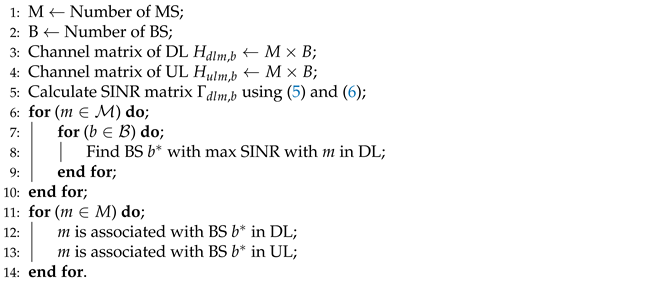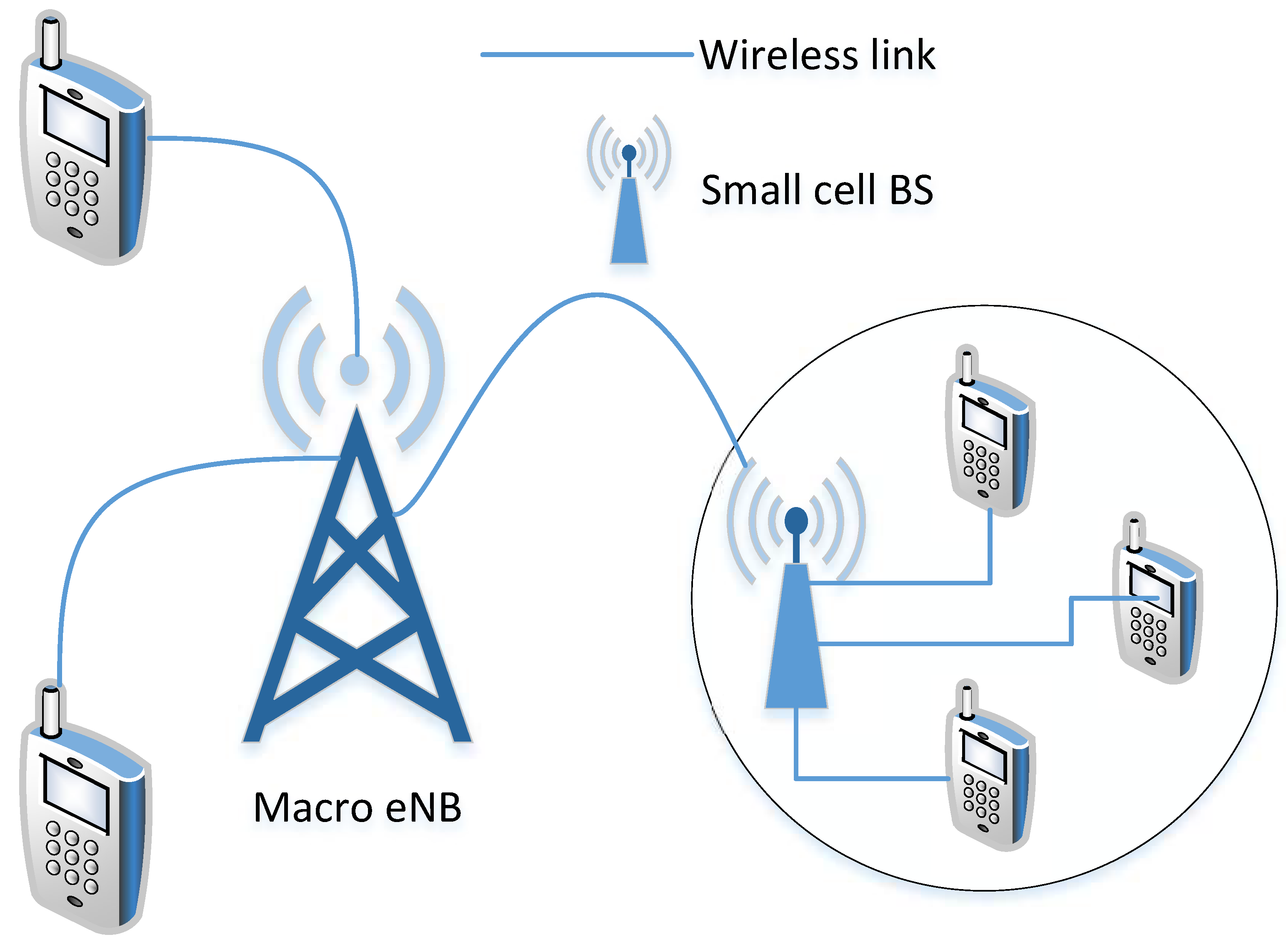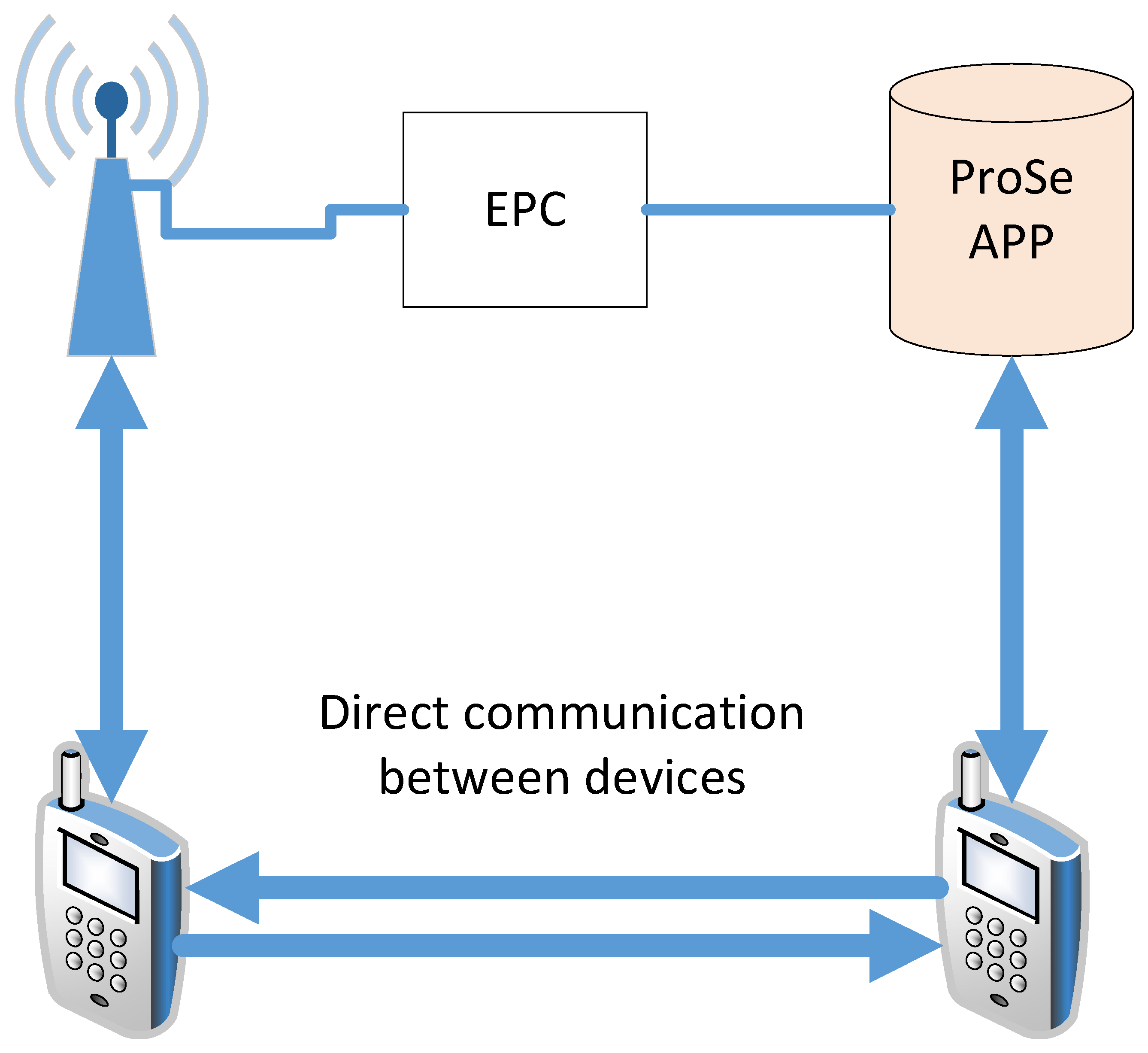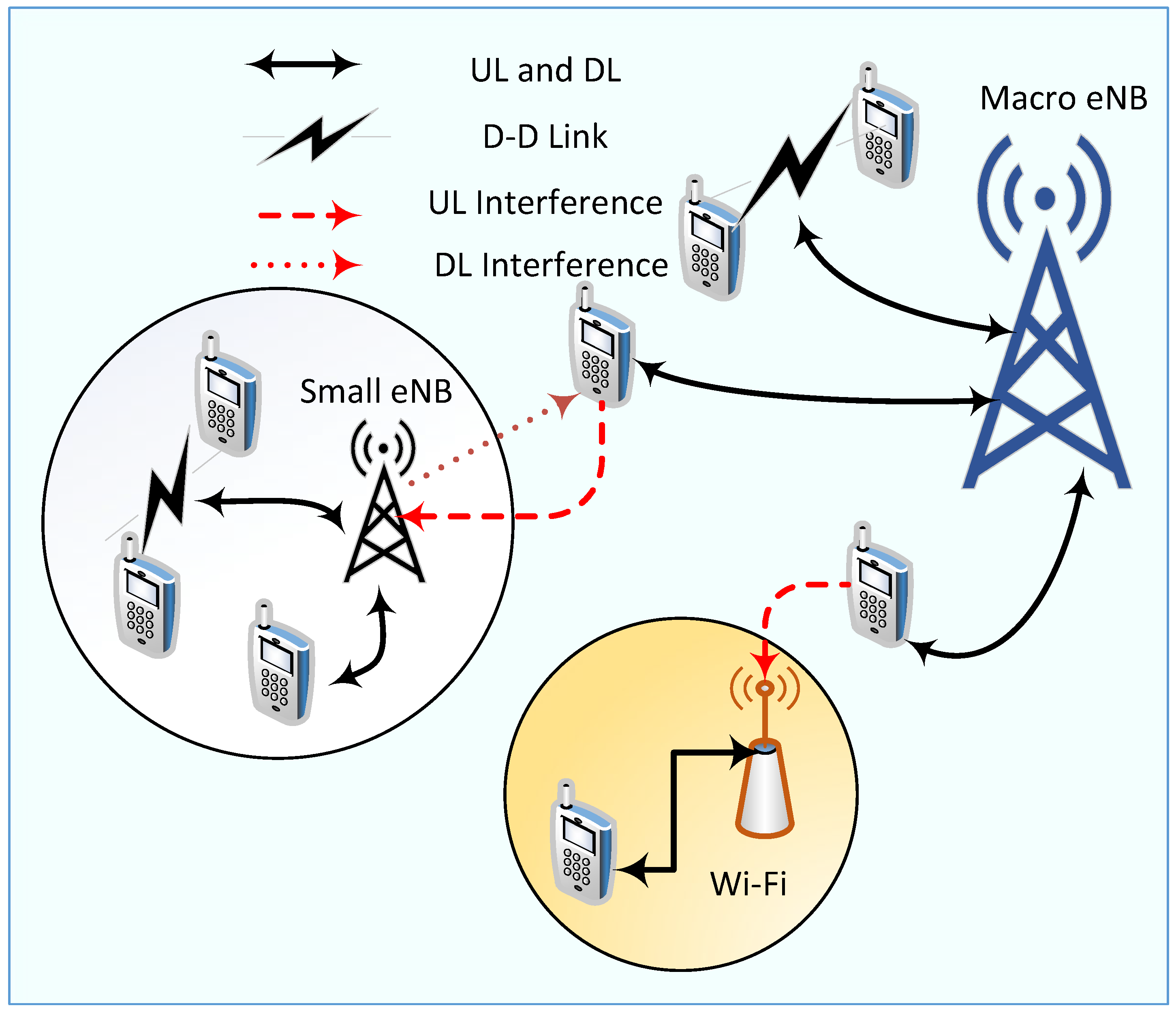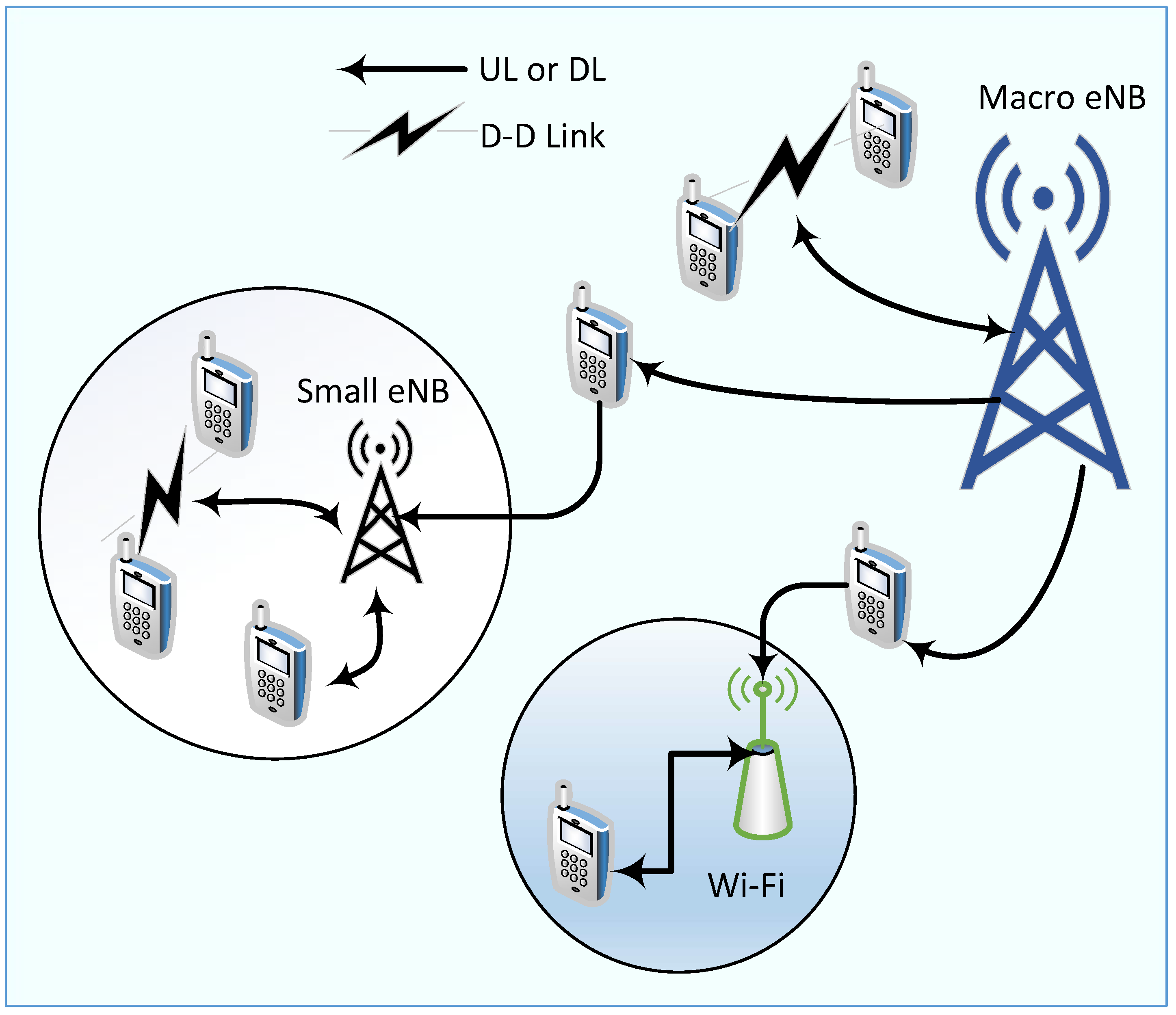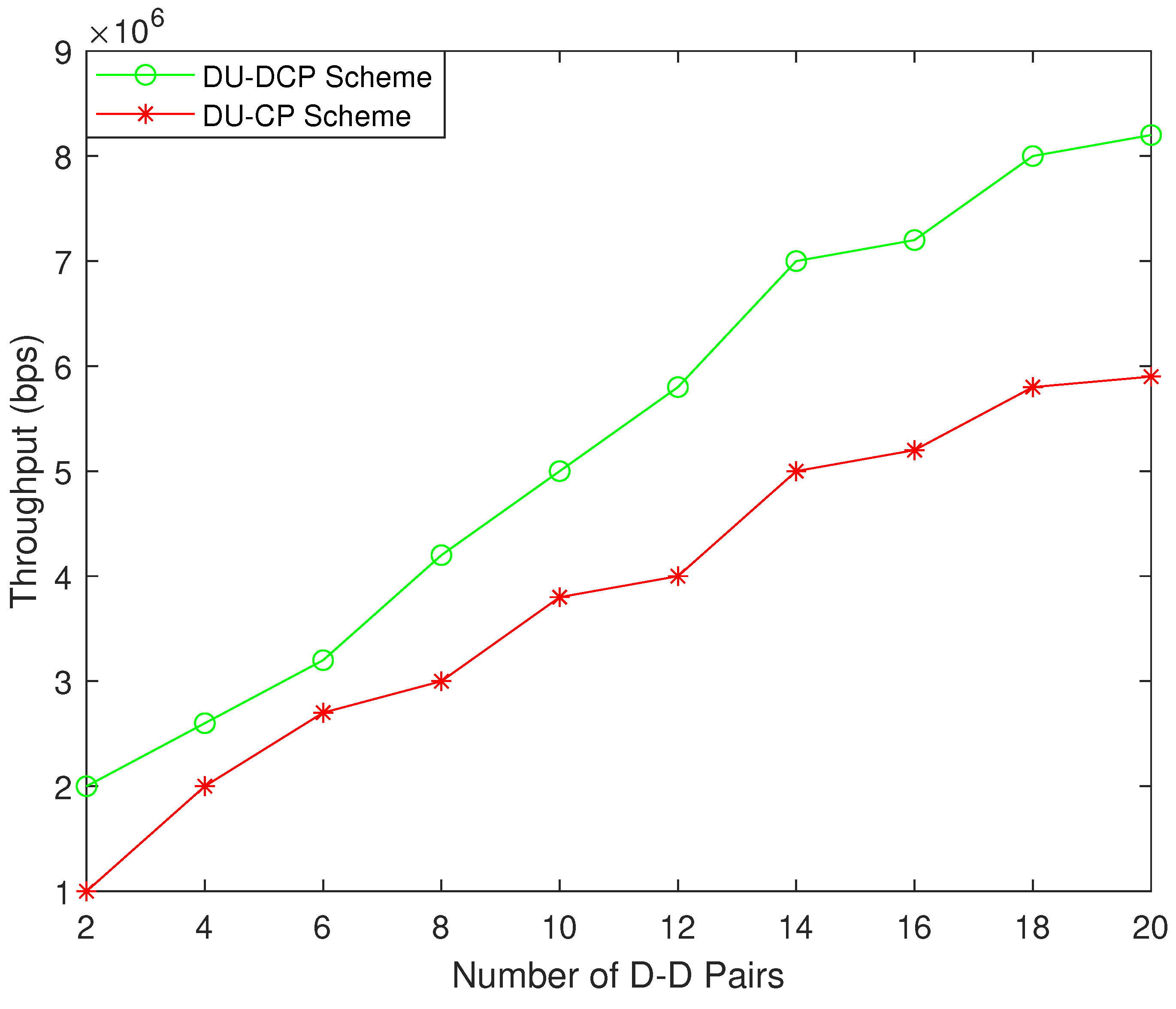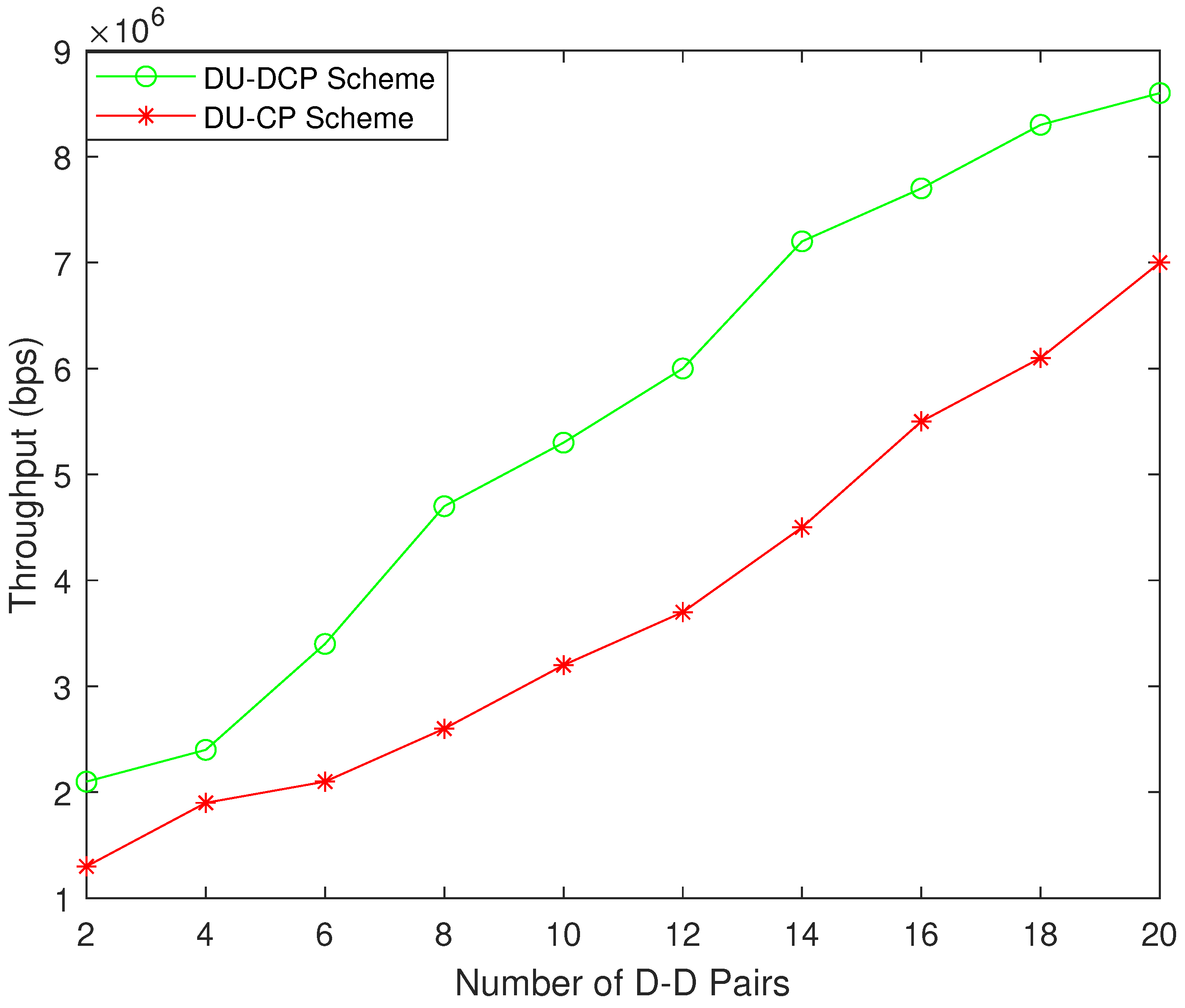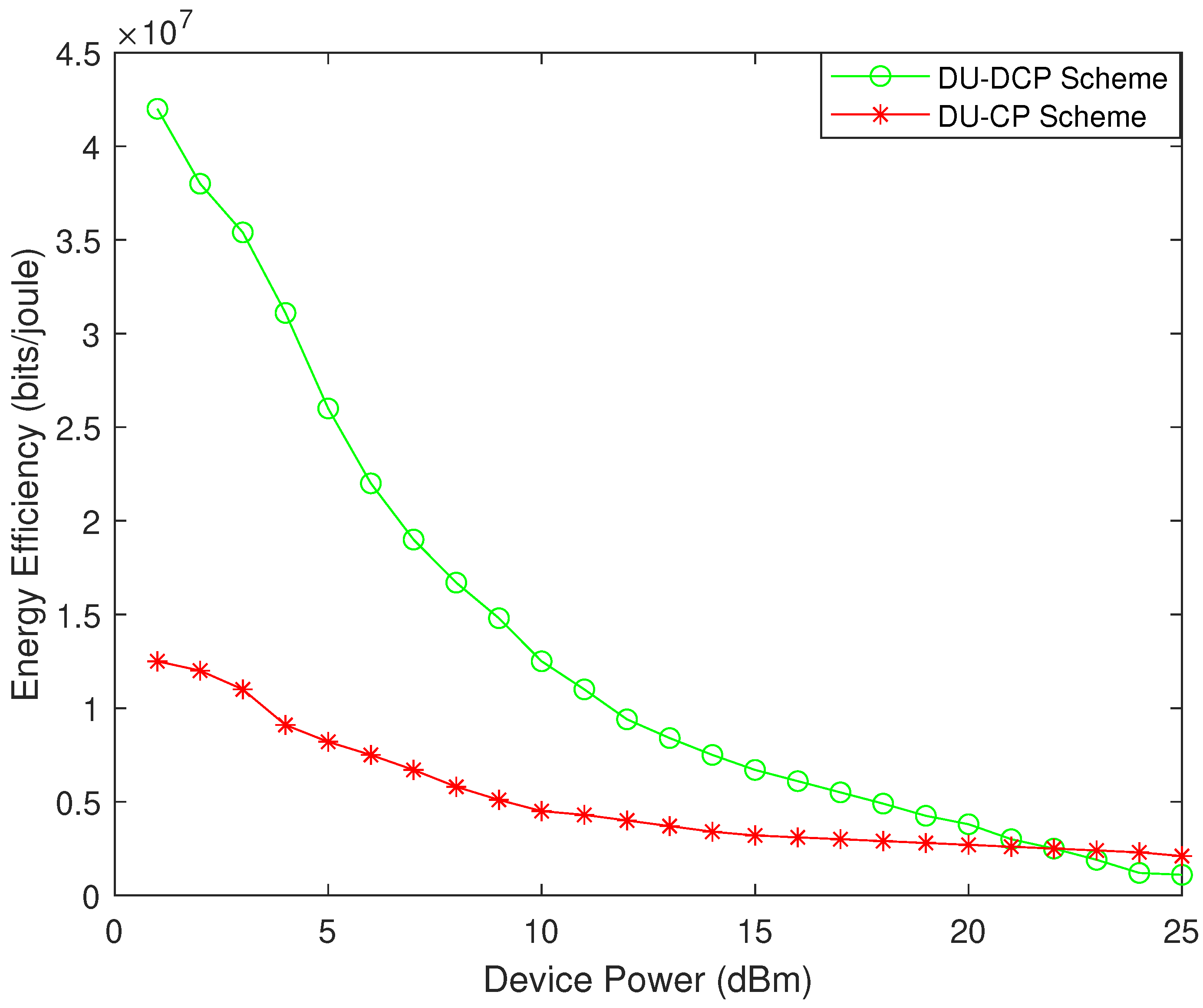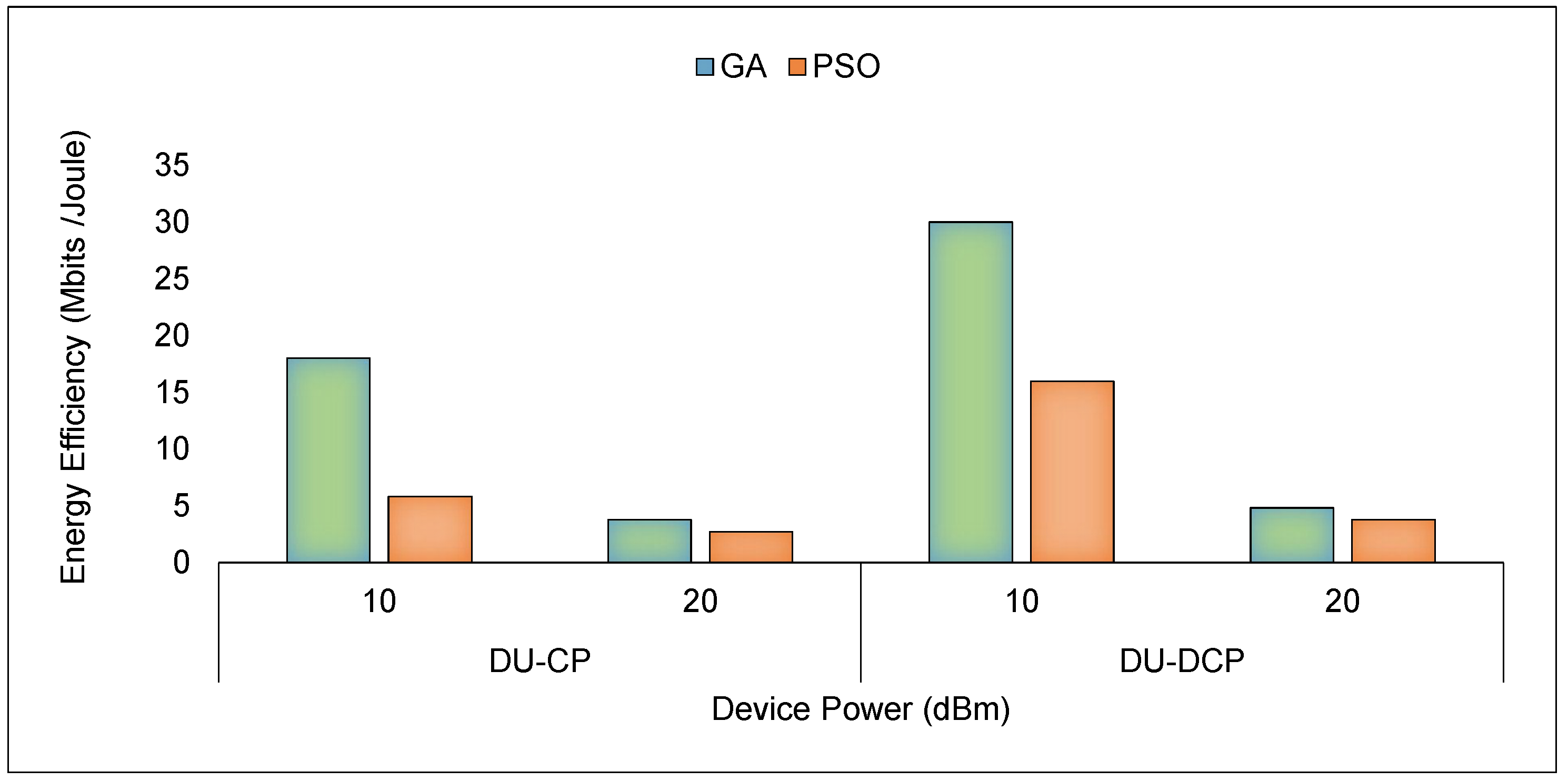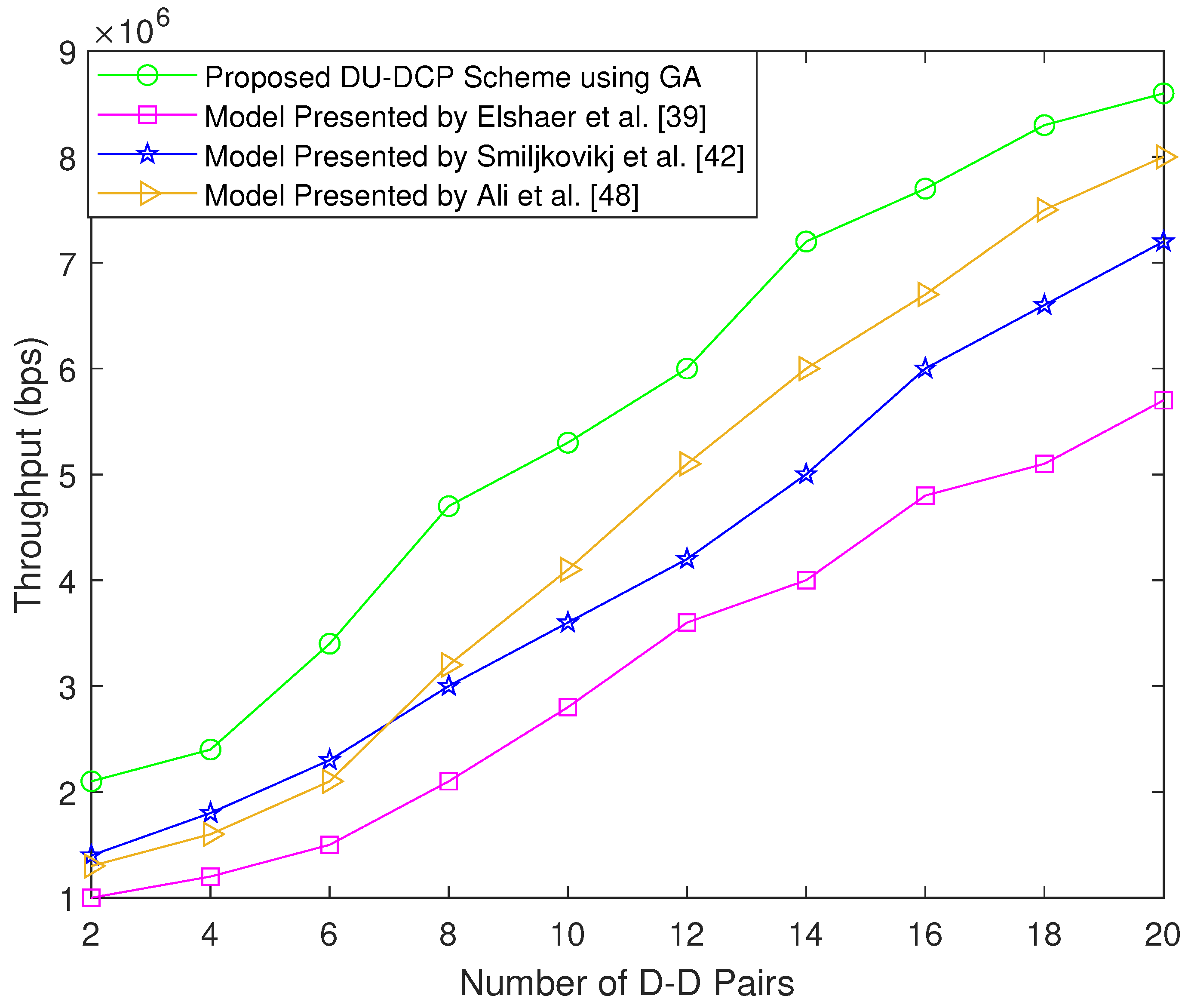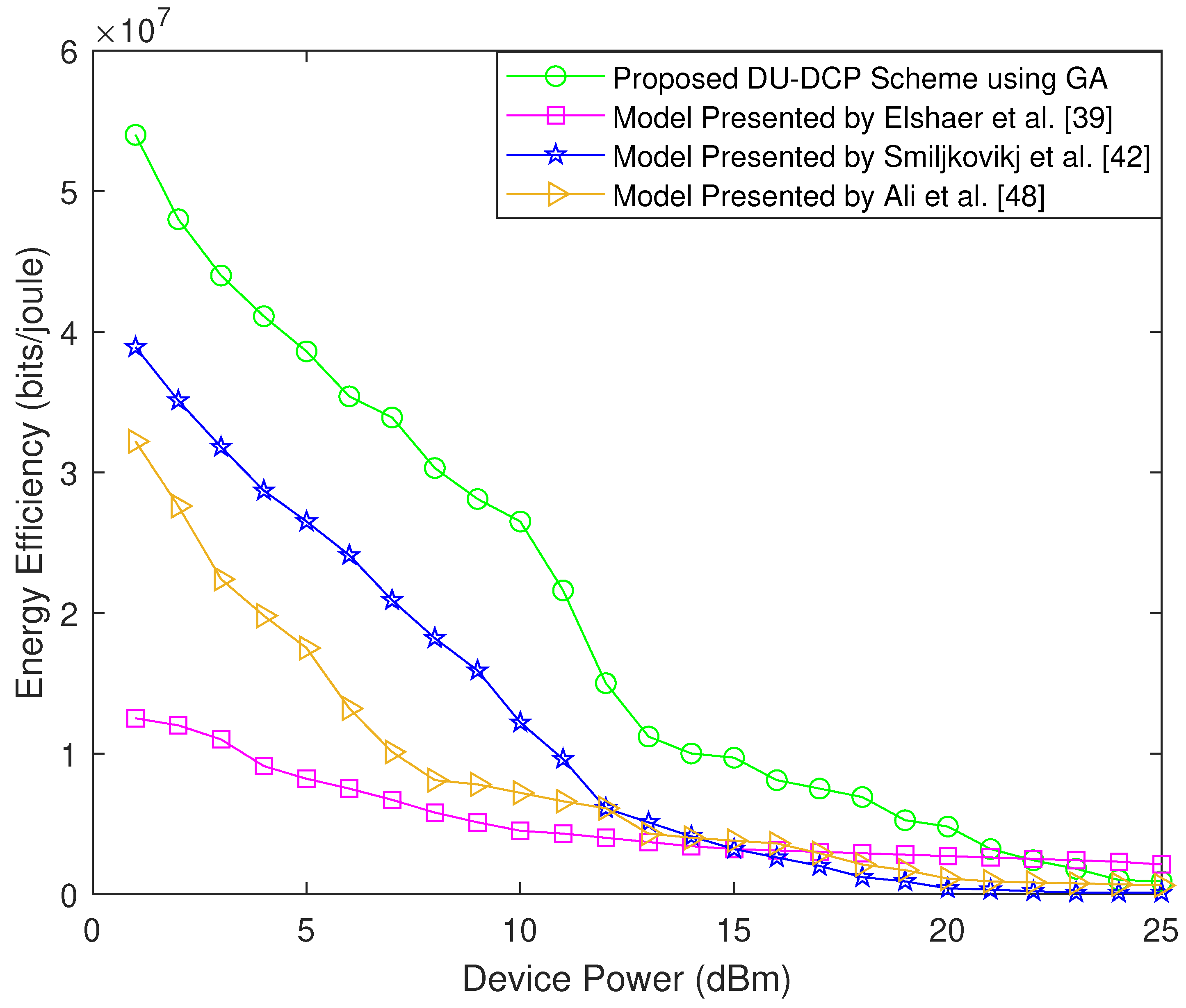1. Introduction
Device-to-device (D2D) communication is an important part of newer generations of cellular networks due to its low latency and other advantages. It permits user equipment (UE) in close proximity to communicate via a direct link instead of routing communication through the network. In D2D communication, devices can transmit or receive data without assistance from the base station (BS); thus, the overloading of the BS is reduced, and the system throughput is increased. D2D communication underlays the existing cellular network and shares resources of users, which can induce co-channel interference. Reducing this co-channel interference is one of the important challenging tasks in D2D communication. For this reason, many research investigations in the communication world have presented various schemes from different perspectives, e.g., radio networks based on a cloud, energy-aware communications, and dense heterogeneous networks via a wireless channel [
1,
2]. Among all of the proposed schemes, dense heterogeneous networks (HNs) that are based on Long-Term Evolution-Advanced (LTE-A) may be particularly useful because aggregation can result in better energy efficiency [
3] and greater bandwidth. Especially with 5G, small cells (SCs), which include pico cells and femto cells, can be deployed with ease to enhance the capacity of 5G via the off-loading of macro-cell (MC) traffic to the SCs.
One of the major problems in D2D communication is interference management in resource allocation. Resource sharing with cellular users causes interference, which affects the performance of the network. In [
4], the authors proposed a strategy for interference management using orthogonality between D2D links and cellular links. On the other hand, direct D2D communication is not possible if the distance between the devices is increased. Thus, a relay must be inserted between the devices, and it can become a two-hop communication. In [
5], the authors proposed an algorithm for two-hop D2D communication based on a relay to increase the performance of the network. In a 5G network, the number of D2D users can be more than the number of cellular users in some scenarios, and this condition is considered to be an ultra-dense D2D network. For this scenario, another approach needs to be followed for efficient resource allocation. Network resources will be allocated first to D2D pairs and then to cellular users. The authors in [
6] proposed an alternate resource allocation algorithm for an ultra-dense cellular network.
The deployment of 5G meets various requirements of D2D applications, such as ensuring availability, increasing reliability, and minimizing latency. Moreover, it also provides an opportunity to increase energy efficiency and enhances security. The primary enabling technologies that 5G can provide include advanced coding methods, congestion-reducing techniques, and support for heterogeneous networks (HN) as well as software-defined networks. A simplified HN is shown in
Figure 1, and a D2D model is illustrated in
Figure 2.
Wireless devices and mobile phones with applications such as live gaming, video streaming, and social networking have induced rapid growth in mobile traffic. After a deep analysis of these trends, it has been predicted that almost 71% of IP traffic will be utilized by wireless devices by the year 2022 [
7]. Industry and academic organizations have initiated research into new areas [
8,
9,
10,
11], e.g., massive multiple-input–multiple-output (MIMO), moving toward the millimeter wave (mmWave) spectrum, and deep densification for handling flooded mobile traffic that has been predicted in advance. Deployment of small BSs in the existing 3G network with a macro BS has led to the achievement of extreme densification among all of these methods. By achieving this task, it was possible to bring end users closers to the radio access nodes [
12]. BSs in femto cells and micro cells have a small size, reduced cost, and low power consumption. Therefore, extreme densification has achieved targets such as enhanced coverage, improvement in capacity for cell users, and traffic off-loading in the 4GHN [
13,
14,
15,
16]. The 4GHN makes use of the DU-CP scheme in which the MS is associated in UL and DL with the same BS. The DU-CP is based on the strong signal-to-interference-and-noise ratio (SINR) in DL offered from the macro BS and many small BSs. A low-powered micro BS indicates that the MS might be associated in UL and DL with controlling a macro BS with a higher SINR. Therefore, an MS that is associated with a macro BS will have greater interference during UL in closely located BSs. For this reason, the DU-CP access method causes performance degradation in the 4GHN. In this context, an improved cell association scheme was given by many authors in [
17,
18,
19] in which an MS can associate with a different BS or the same BS in UL and DL in an HN. This improved scheme is known as the DL-and-UL-decoupling (DU-DCP) access scheme. This scheme has represented the gains of sum rates in dense HNs by an order of 200–300% [
19].
Recently, energy efficiency has been considered an important aspect of wireless heterogeneous networks. Many energy efficiency techniques for wireless networks have been proposed in the literature, and some of these techniques have been investigated specifically for the energy efficiency of a base station (BS) [
20,
21,
22]. In [
23], the authors made a classification system for the energy efficiency techniques consisting of five types.
Table 1 provides a summary of these classifications.
Heuristic algorithms have been designed to tackle different problems in 5G HNs, and many research investigations have been conducted related to these in order to improve the performance of the network. The genetic algorithm (GA) and particle swarm optimization (PSO) are among the well-known optimization algorithms that may be used for this purpose [
24]. Whereas the GA is based on various biological techniques, such as inheritance, selection, crossover, and mutation, the PSO uses the swarming behavior of certain living organisms.
In both the PSO and GA [
25], a collection of solutions is generated randomly as the starting point, and each solution is termed a population, which is represented by a series of values. The GA helps evolve the population by several generations, during which the most important point is the mutation, as it produces a pseudorandom change. However, in the PSO, each solution moves inside the design space. In each step, the position of each candidate solution changes according to its current speed. Each algorithm has unique characteristics, and the performance of either of the two algorithms depends on the nature of the problem. Whereas the PSO may be good at solving unconstrained optimization problems with continuous variables, the GA is better suited to constrained problems with discrete variables. The GA is also able to handle the complex problems commonly encountered in engineering systems with ease due to its parallel nature [
26].
Table 2 compares both of these algorithms and lists the prominent features of the GA and PSO [
25,
26,
27,
28,
29].
The GA and PSO have previously been used in 5GHNs for various purposes, including energy efficiency and throughput maximization. In [
30], the authors propose a GA-based energy efficiency scheme for 5GHNs called ESGA-5G. The GA-based scheme performs better than the PSO and achieves a higher percentage of energy efficiency compared to the PSO. In another work [
31], energy optimization is investigated in energy-harvesting-enabled mmWave unmanned aerial vehicle (UAV) HNs. The results show that the performance of the GA and that of the PSO achieve comparable network energy efficiencies. The GA and PSO, along with other algorithms, are used for energy efficiency and throughput maximization in mmWave- and microwave-based 5GHNs in [
32]. This work compares many algorithms for the optimization of energy and throughput. The results show that the GA performs better than many other algorithms, including the PSO, for both energy efficiency and throughput maximization.
In our work, we leverage the PSO and GA to investigate and compare the DU-CP and DU-DCP cell association strategies. Previously, the DU-CP and DU-DCP schemes were studied only in the context of two-tier and three-tier HNs. In this work, we investigate these schemes for cell association in four-tier HNs in terms of energy efficiency and network throughput. The main contributions of this paper are as follows:
The performances of the DU-CP and DU-DCP access schemes are evaluated and compared in four-tier HNs. The previous work considered only two-tier or three-tier HNs.
To optimize the results of the two schemes, a maximization problem is formulated.
We use the GA and PSO for the comparison of both schemes in terms of network throughput and energy efficiency.
Simulation experiments are conducted for a performance evaluation of the two strategies. The results reveal that the DU-DCP cell association strategy performs better than the DU-CP method in terms of both throughput and energy efficiency. Furthermore, the GA produces better results compared to those of the PSO for the two metrics using either the DU-CP or DU-DCP cell association strategy. The performance of the DU-DCP with the GA is also compared with three other methods. The results show that our proposed strategy has a significant performance advantage over the compared methods.
2. Related Work
In an HN, cell association is an important factor that ensures energy efficiency by load balancing and interference management. Furthermore, it is also leveraged for throughput maximization. Cell association can be defined as the procedure that searches for a suitable BS for user equipment according to a given set of parameters [
33]. Several cell association methods have been discussed in the literature for various sets of metrics [
34,
35,
36].
Yang et al. [
37] considered the received signal power and path losses to formulate cell association methods in inter-frequency and intra-frequency conditions. Singh et al. [
38] proposed an algorithm based on cell association to enhance the sum rate and load balancing between a small BS and a macro BS. For the rate coverage probabilities in DL and UL among a decoupled association, Elshaer et al. [
39] proposed an expression using stochastic geometric tools. Celik et al. [
40] considered some objectives, for example, the maximum and minimum fairnesses, to investigate the resource allocation for non-orthogonal multiple access strategies for a decoupled HN. Elshaer et al. [
41] formulated a strategy using a trail network of small cells that considers some constraints, e.g., the cell load and back-haul capacity.
Smiljkovikj et al. [
42] formulated an expression representing the associated probability for devices in a decoupled HN and also described its effect on the overall throughput gain in an HN using stochastic geometry. Shi et al. [
43] investigated the user association in a small cell (typically sub-6GHz) as well as in an mmWave small cell using the DL-and-UL-decoupling access strategy. Jia et al. [
44] explored and evaluated the dual connection for all possible DL-and-UL-decoupled access types. After simplifying the conditions of the association, he derived the association and the UL coverage probabilities by using stochastic geometric tools. An optimally distributed dynamic scheme based on time-division multiplexing (TDM) was proposed by Razlighi et al. [
45] by investigating the throughput maximization and cell association in a DU-DCP HN.
Cell association strategies were explored by Sekander et al. [
46] using game theory, and the authors represented the efficacies of the proposed models in terms of key performance indicators (KPIs), e.g., decoupled and coupled associations, user rates, and the number of non-associated users in UL and DL in the DU-DCP HN network. A frequency reuse method was proposed by Zheng et al. [
47] to explore cell association for the mitigation of interference in the DU-DCP HN environment. Ali et al. [
48] solved many problems, including cell association and power control, by keeping in mind the maximization of the overall data rate via the use of the outer approximation algorithm (OAA).
Efficient resource allocation and utilization were studied by Elshaer et al. [
49] via the formulation of the association of cells method in a DU-DCP HN. Chen et al. [
50] formulated a spectrum allocation and load-balancing technique using machine learning to maximize the sum rate in the DU-DCP system. A trade-off between the energy and spectral efficiencies during UL transmission in a three-tier HN with macro cells and pico cells associated with D-D communication was examined by Pervaiz et al. [
51]. Resource-sharing techniques with energy-efficient maximization for a DL transmission in an HN were studied by Naqvi et al. [
52]. Omar et al. [
53] explored energy efficiency and spectral efficiency using a sub-6 GHz mmWave small cell during downlink transmission for a multi-tier HN. A summary of the reviewed work is provided in
Table 3.
After a detailed review of research work from the past, it is concluded that the DU-CP scheme in the 4GHN provides a sub-optimal solution for increasing heterogeneity as well as a significant transmission power among low-powered small BSs and high-powered macro BSs. The following gaps remained untouched by researchers in previous works:
The DU-DCP access scheme is analyzed by the researchers studying only two-tier and three-tier HNs.
The performance analysis of the DU-CP scheme versus the DU-DCP scheme in a four-tier HN is an open research area as not much research has been conducted regarding this aspect.
The existing research does not consider mobile data traffic from the user point that is associated with UL and DL in a four-tier HN.
Hence, after reviewing the research conducted in the past and considering the gaps, this research work takes into account the performance analyses of the DU-CP access in comparison with those of the DU-DCP access for cell association, energy efficiency, and maximization of the sum rate in a four-tier HN. The research work presented in this paper compares the DU-CP access and the DU-DCP scheme using heuristic algorithms in a four-tier HN. Another unique aspect of our work is the exploitation of the GA and PSO for the performance comparison of the DU-CP and DU-DCP access schemes in a four-tier HN.
3. System Model
In one-tier HN [
54,
55], the network carrier has direct connections with the UEs, which are used to deliver data. In a two-tier HN, micro cells are deployed in addition to macro cells. Therefore, some UEs are served through the micro cells, which are, in turn, served by the macro cells. In a three-tier HN, femto and pico cells are deployed with the macro cells. In a four-tier HN additional communication paradigm, such as ours, D2D communication is also possible.
In four-tier HN communication, wireless signals are transmitted to and from different tiers with different levels of power. It can be a source of interference for a BS if the neighboring BSs have high transmission powers. Therefore, the transmission power is allocated such that interference is avoided. Hence, the number of mobile users that a BS can serve is dependent on its coverage resulting from the transmission power. Therefore, in four-tier communication, multiple BSs can serve a large number of users by using the cell associations of different tiers [
56,
57,
58]. However, this added benefit is at the cost of additional complexity. It is easier to implement and optimize, for example, a one-tier network since the number of variables to be optimized is small. However, in a four-tier network, the number of variables to be optimized is large due to the different tiers. Hence, the implementation and optimization of a four-tier HN are relatively complex compared to lower-tier HNs.
According to [
56], the DU-CP and DU-DCP access schemes, in terms of cell association, have been explored in a four-tier HN. Two scenarios of communication in the traditional DU-CP access, as well as the innovative DU-DCP access, related to cell association in a four-tier HN, are shown in
Figure 3 and
Figure 4, respectively. These scenarios are also described as follows:
DU-CP HN: In this scenario, the MS
m is associated with the same BS, e.g., a small eNB, macro eNB, WiFi, and D2D, in the UL and DL methods based on the DU-CP access scheme, as given in
Figure 3. Here, all MSs that are associated with a macro eNB during UL and DL near the cell edge create interference with a small eNB while transmitting in UL using the DU-CP HN, which is shown by the red dotted lines in
Figure 3.
DU-DCP HN: In this scenario, the MS
m can be associated with a different or the same BS, e.g., a small eNB, macro eNB, WiFi, and D2D, in UL and DL based on the DU-DCP access scheme, as shown in
Figure 4. In this type, all MSs near the cell edge are associated with different BSs in UL and DL, and performance losses are avoided in the DU-DCP HN due to interference during UL in the DU-CP.
A four-tier HN, as described in [
56], consisting of a small eNB, macro eNB, D2D, and WiFi, is considered in this paper in which all base stations and mobile stations (MS) are distributed uniformly within the network. The four-tier HN nodes try to avoid inter-tier interference by operating at different frequencies. A small eNB, D2D, and WiFi serve as the traffic off-loader by operating at a lower power.
Let there be
M number of MSs so as to form the set
. The BS
b, where
, and
, serves the mobile station
m in UL and DL for the DU-CP HN. However, the MS
m aims to be served by a different or the same BS in UL and DL in the DU-DCP HN, with a link
, where
.
Let the variables
and
represent that MS
is admitted for communication in UL or DL, respectively, as follows
Similarly, let the variables
and
represent that the MS
m is associated with the BS
b for communication in UL and DL, respectively, as follows:
The channel gain
in the case that the MS
m is associated with the BS
b is given by:
where
represents the Rayleigh random variable,
is the antenna gain,
is the zero-mean Gaussian random variable,
is the distance between the MS
m and the BS
b,
is the path-loss exponent. The path loss is given by:
where
is the average path loss at a reference distance
. The channel capacities of the MS
m, which is associated with the BS
b in DL and UL, are given by:
where
and
are the signal-to-interference-and-noise ratios in UL and DL, respectively. As discussed in [
56], two types of SINRs are experienced both in UL and DL when the MS
m associates with the BS
b.
DL-DL Interference: Let us consider an MS
m that is associated with a BS
b to receive data from it in DL. A neighboring base station
, which is also transmitting in DL to another MS
, will cause interference in the communication between the BS
b and MS
m. This interference is termed DL-DL interference, and the SINR
at the MS
m with interference from the neighboring base stations
is as follows:
where
and
are the transmission powers of the base stations
b and
, respectively, in DL;
and
are the channel gains from the respective base stations
b and
to
m; and
is the noise power.
UL-DL Interference: When an MS
m is associated with a BS
b to receive data from it in DL, then a neighboring MS
will cause interference in the communication between the MS
m and the BS
b during transmission to a base station
in UL. In this case, the SINR
at the MS
m with interference from
is as follows:
where
is the transmission power of
in the uplink, and
is the gain of the channel from
to
m.
UL-UL Interference: If an MS
m transmits data to an associated BS
b in UL, then the communication in UL between another MS
with its associated BS
will be a source of interference for the former communication link in UL, and this is referred to as UL-UL interference. In this case, the SINR
at the BS
b with interference from
is as follows:
where
is the transmission power of
m in the uplink, and
and
are the channel gains from the respective mobile stations
m and
to
b.
DL-UL Interference: Let us consider an MS
m transmitting data to an associated BS
b in UL. A BS
transmitting to another MS
in DL will cause interference to the UL communication between the MS
m and the BS
b. In this case, the SINR
at the BS
b with interference from
is as follows:
where
is the channel gain from
to
b.
The energy efficiency of the system is obtained by considering the ratio of the obtained data rate and the transmitted power. Considering a
W bandwidth, this is given by:
where
This paper describes cell association and sum-rate maximization using a traditional DU-CP method and innovative DU-DCP access methods in the HN.
Table 4 gives a summary of the notations and symbols used in this paper.
4. Rate Maximization
The main aim of this work is to focus on energy efficiency and throughput maximization, for which we consider a single cell consisting of cellular users and D2D pairs. Our objective is to maximize the sum rate using the DU-CP and DU-DCP access methods in an HN while ensuring the QoS requirements of the MS. The optimization problem for the DU-CP access scheme can be formulated as follows:
The objective function aims to maximize the sum rate using optimum associations in an energy-efficient manner subject to a number of constraints. Constraint (12b) ensures that an MS is associated with at most one BS. According to constraint (12c), the received power of an MS in DL is always less than the maximum power of the associated base station. There is no received power when the MS is not admitted in DL. Similarly, the power received by a BS from an associated MS is less than the transmission power of the MS, and this is possible only in UL. This is ensured by the constraint (12d). Constraint (12e) provides a quality of service (QoS) guarantee and ensures that the data rate obtained by m with b using link l is always greater than the minimum rate requirement. To confirm that an MS m admitted in DL is associated with the BS b in DL and that an MS m admitted in UL is associated with the BS b in UL, constraint (12f) is introduced. Constraint (12g) is for DU-CP access, ensuring that an MS m is associated with the same BS b in DL and UL. The optimization problem for the DU-DCP access method is the same as (12) after removing constraint (12g) i.e., (12a)–(12f) constitute the DU-DCP access optimization problem.
Two communication scenarios using the DU-CP and DU-DCP access methods are considered.
In the DU-CP scenario, the MS
m is associated with the same BS in UL and DL, as given in
Figure 3. This is described in Algorithm 1.
The channel and SINR matrices are determined first. Next, the BS with the maximum SINR with
m in DL is determined. Based upon the DU-CP access scheme, the MS
m is associated with the BS with the maximum SINR in DL.
In the DU-DCP access scheme, depicted in
Figure 4, an MS
m can be associated with a different or the same BS in UL and DL depending upon the SINR. This is achieved as described in Algorithm 2.
As in the case of the DU-CP scheme, the channel matrix for the channel between the MS and the BS is generated in the first step. However, the SINR matrices for both DL and UL are established. The BS with the strongest SINR in DL is associated with the MS in DL, and the BS with the strongest SINR in UL is associated with the BS in UL.
| Algorithm 1 DU-CP Algorithm. |
![Electronics 12 02031 i001 Electronics 12 02031 i001]() |
| Algorithm 2 DU-DCP Algorithm. |
![Electronics 12 02031 i002 Electronics 12 02031 i002]() |
5. Simulation Results
The performance of the DU-CP access method is compared with that of the DU-DCP in a four-tier HN using the genetic algorithm (GA) and particle swarm optimization (PSO).
We use MATLAB R2020b with its Communications, LTE, and 5G Toolboxes to implement a heterogeneous network. The Global Optimization Toolbox is used for the optimization using the PSO and GA. Several simulation experiments are performed for the evaluation of the two cell association strategies. The parameter settings used in the simulations are given in
Table 5. The results are plotted for the illustration of the performance comparison of the two schemes.
Figure 5 represents the throughput of the network for the DU-CP and DU-DCP schemes using the PSO. It can be seen that if more devices are connected using a D2D link, then the throughput of the network is higher for the DU-DCP method than for the DU-CP scheme. Similarly, in
Figure 6, the throughput of network is given using the GA for the DU-DCP and DU-CP methods. Comparing
Figure 5 and
Figure 6, it can be seen that the GA gives better results in terms of throughput for the DU-DCP method. Compared to the PSO, the GA provides a 10% better throughput on average for the DU-DCP method.
Figure 7 shows a quantitative comparison of the network throughputs achieved by the DU-DCP and DU-CP schemes using the PSO and GA. It further confirms that the GA gives better results for the DU-DCP method than for the PSO algorithm.
Figure 8 and
Figure 9 represent the energy efficiency of the DU-CP and DU-DCP schemes using the PSO and GA, respectively. From
Figure 8, it can be seen that the DU-DCP scheme gives a better performance than the DU-CP method using the PSO. Similarly, in
Figure 9, again, it can be seen that the DU-DCP performs better than the DU-CP method using the GA as well.
Figure 10 provides a quantitative comparison of the energy efficiencies of both schemes using the PSO and GA. It can be observed that the energy efficiency using the PSO for the DU-DCP method is 30% better than the DU-CP method. It is also seen that the GA gives almost a 27% better energy efficiency for the DU-DCP method on average than the DU-CP method. Moreover, the DU-DCP scheme shows an overall better energy efficiency in comparison to that of the DU-CP scheme using both the GA and PSO. It can be further noted that energy efficiency reduces as the number of devices increases. This can be explained by considering the fact that a higher number of D2D transmitters causes an increase in the interference, and, thus, the transmission rate is degraded, which in return reduces energy efficiency. In a 5GHN system, in the case of a large number of users, the energy efficiency for an HN can reduce due to inter-cell interference. To alleviate this and to reduce inter-cell interference, coordination techniques may be used.
From the results, it is evident that the GA performs better than the PSO in the cases of both the DU-CP and DU-DCP. This is due to the fact that the discrete and parallel nature of the GA is better suited to the DU-CP and DU-DCP problems than the PSO. The main operations in the GA are selection, crossover, and mutation, which help it achieve a better performance. These results are in agreement with the results obtained in other similar works reviewed in
Section 3. For example, the GA-based energy efficiency scheme ESGA-5G, proposed in [
30], achieves better results than the PSO, as is the case in our work. Likewise, in [
32], the performance of the GA is reported to be better than the PSO.
We compare the performance of our proposed method with the schemes proposed by Elshaer et al. in [
39], Smiljkovikj et al. in [
42], and Ali et al. in [
48]. For the purpose of comparison with these methods, we use our DU-DCP scheme with the GA since it has been observed from the previous results that the GA gives better results for the proposed model than the PSO.
Figure 11 shows a comparison of the throughput of the proposed system and the models presented in [
39,
42], which use the stochastic geometry approach, and the model in [
48], which uses outer approximation. From
Figure 11, it is evident that the proposed model outperforms the compared models given by [
39,
42,
48] in terms of network throughput. The DU-DCP scheme gives approximately a 29% higher throughput using the GA as compared to the network model in [
39]. Similarly, the proposed scheme achieves almost a 14% and 7% higher throughput as compared to the models presented in [
42,
48], respectively. It is also observed from
Figure 11 that, initially, the model in [
42] gives a slightly better throughput than the model in [
48]. However, as the number of connected devices increases, the throughput using [
48] increases more rapidly as compared to [
42].
Figure 12 shows a comparison of the energy efficiencies of the proposed model and the models in [
39,
42,
48]. It is observed from
Figure 12 that the DU-DCP scheme with the GA presented in this work gives an overall better and more energy-efficient performance on average than the compared methods. It is also observed from
Figure 12 that, initially, the models in [
42,
48] give better energy efficiency than the model in [
39]. However, as the device power increases, the energy efficiency of [
42,
48] decreases more rapidly as compared to [
39]. Moreover, from
Figure 12, it can also be seen that the DU-DCP with the GA gives an approximately 18% higher energy efficiency than the model in [
48]. Therefore, it can be concluded from
Figure 12 that, on average, the proposed DU-DCP scheme using the GA outperforms the compared schemes in terms of energy efficiency. All of the schemes give similar performances when the device power is high. Hence, from the results in
Figure 11 and
Figure 12, it is evident that better results in terms of both energy efficiency and network throughput can be obtained using the proposed optimization strategy than the stochastic geometry and outer approximation approaches, as used in [
39,
42,
48].
